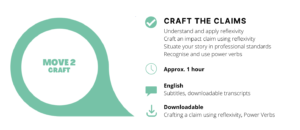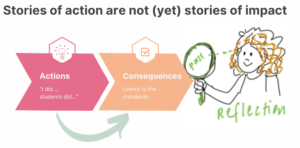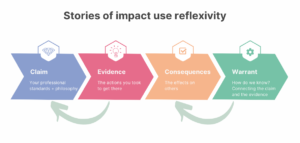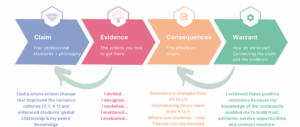If our stories are the fabric, then it is the intricate work in selecting its threads where storytellers develop the self-knowledge and authenticity inherent in a leader (Layen, 2015). This weaving of threads, or professional story-crafting, is the identity work that develops and refines us as leaders. Move 2 steps us through the concept of reflexivity so that we can identify our claim of impact.

Stories that effectively demonstrate impact are crafted differently from narratives that follow chronological order or a sequence of events that lead to a climax. Impact stories start with this peak and then share the actions that got them there. This peak, which should be aligned with your professional standards, is known as your claim of impact.
How do I turn a story of what I did into a claim for impact?
The claim of our story is what turns a sequence of work actions into a meaningful story of impact. To generate a claim, we must be reflexive or start at the back of our story. But how?
When we tell someone else about an event, we usually organise it in chronological order. For example, this is the order of a story about actions and consequences rather than a story demonstrating impact:

In action stories, it is only when we get to the end of that story that we will make a statement about why that event was significant or important. This conclusion is the first place to look when you want to find your claim for impact. This is what we call ‘reflexivity’ or bending back. It looks like this:

So, the first step you may like to take is to write your story of what happened. Then pay attention to the conclusion and why this series of events has stayed in your memory, or why it was the one you have chosen as a good story to tell.
Here’s an example of an effective claim using this reflexive process to bend back on evidence and consequences:

As illustrated above, an effective claim will be a summary sentence of what the evidence can show. It is like a thesis for an argumentative essay. The key words in the claim are signposts to what evidence is coming up for the reader. It is also will also help you organise your story as the signposts for structure are there.
Here’s another example of an effective claim:
“I have developed the culture and skills of the team by using the organisation’s strategic priorities to structure meetings.”
In this case, the reader would expect to read about:
- Who was in the team and your role (who was impacted)
- How the culture and skills of the team changed. Before…and now (immediate impact)
- What happened in the meetings to bring about this change (showing your awareness of how to bring about impact).
- Why this achievement of focussing on strategic priorities and team development might be of benefit to the organisation (wider impact)
For more guidance on reflexivity, watch this short video as our mentor, Leanne, guides Kami through her evidence to craft the claims of her story:
Download video transcript here.
Example.
Read this discussion between a teacher and mentor: Example of a teacher brainstorming their actions with a mentor to identify their impact story-
Activity
Now that you have an understanding of high quality evidence and how to turn it into a claim for your story, which of these two claims demonstrate more impact?
-
- My collaborative, and strategic leadership enabled teachers to adapt their practice to be more student centred. I designed and facilitated processes that were supportive, reduced teachers workloads, and enhanced school priorities.
- I led a team of teachers through a collaboration process where they successfully completed some professional development about more student centered teaching. The teachers emailed me to let me know that the professional development helped them feel supported. The professional development meant that they learned skills so they could be more efficient with their time. It was also about a topic that was part of the organisational strategic plan.
You can see what others think by logging your response and using this code: 583-810-709
Now that you have a claim – include the warrant for your story
Representing evidence of impact starts when you make clear claims of why you should be certified, promoted, or recognised in your profession as a leader. While claims detail what you have achieved in alignment with your professional standards, warrants explain how you know that they have made an impact by detailing the evidence and consequences of your actions. You make the evidence or warrant for your claims easy to find when you make links to your professional standards. Annotations also do more than point to the evidence. Annotations help your reader to see the connections within your story.
Use the language of your professional standards – find the power verbs:
When you situate your story in the language or discourse of your profession, you show your reader or assessor that you have an understanding of the culture, and that you belong. You also make it easy for the reader to follow and believe your story.
- Read the annual reports and strategic plans to get a sense of what is important and what activities and priorities are valued in the organisation, and what language to use.
- Find key verbs (see below) or phrases that resonate with you and recycle them in your claims and explanations. This list of power verbs that you can download may help you tell your impact story: Power Verbs
- For teachers, this might look like: “I’ve implemented change … I’ve provided the staff … I surveyed the students … I measured the change in their GPA … engaged with a lot of staff … showed the staff” (1C-C7, C9).
Specific examples of language like professional standards are even more important to consider as they are the criteria that are used to evaluate your story. The Australian Professional Standards for Teachers (APSTs) are a set of standards for supporting teacher quality, professional growth and status of teachers across four career stages: graduate, proficient, highly accomplished and lead. When selecting evidence for a HALT portfolio, teachers engage in self-assessment in relation to the APSTs to determine how they are meeting the professional standards. The APSTS represent benchmark standards of quality and assist the candidate to carefully choose relevant evidence to represent their leadership impact in relation to the APSTs. Usually, one piece of evidence corresponds to multiple APSTs. Providing clear annotations connects your evidence to the APSTs, and will help you to provide a cohesive story of your teacher leadership. There are a range of additional resources on the AITSL website and the websites of certifying authorities to help you craft your claim and annotate your evidence using the APSTs.
Sometimes talking through the ideas with a colleague will help you find the key verbs and the appropriate standards. In the video, Leanne and Kami discuss what key verbs to use to craft a claim:
Download video transcript here.
Put it into practice
- Write: You can craft your claim using this template for reflexive thinking: Crafting a claim using reflexivity
- Share: print the list of power verbs and give them to a trusted colleague. Share your claim with them and ask them for feedback on verbs and how you’ve situated your claim in your professional standards.
- Plan: select a date to complete your next move.